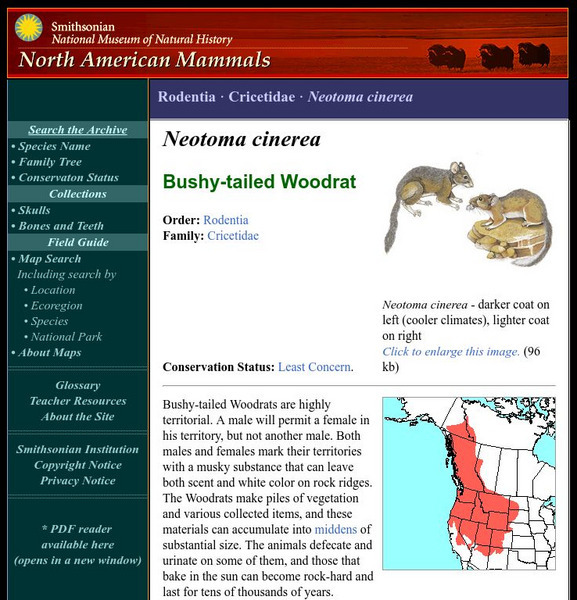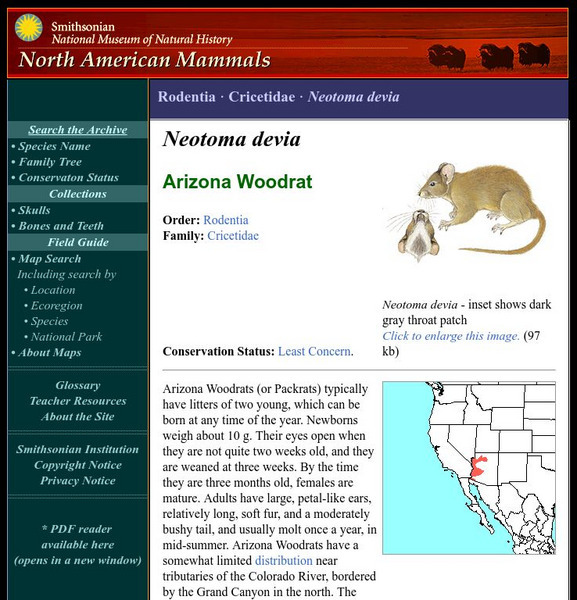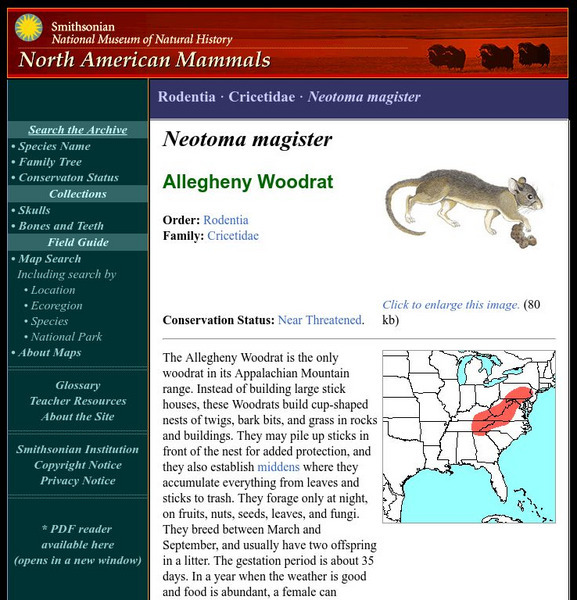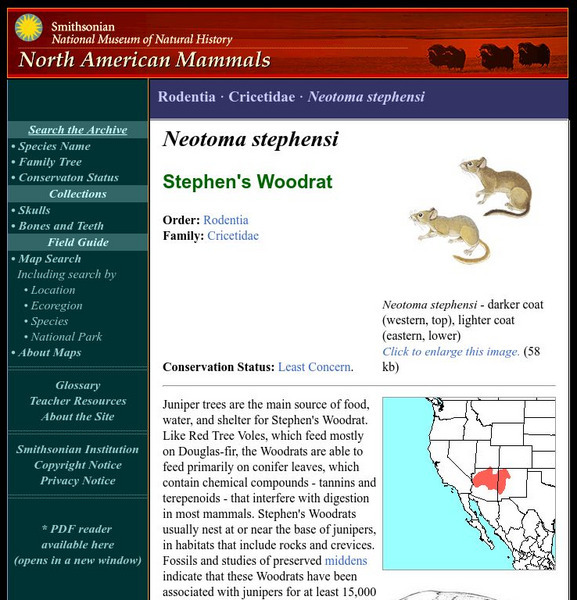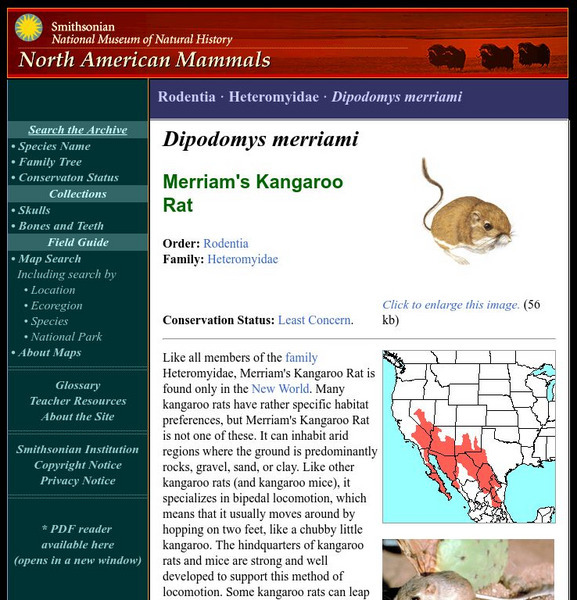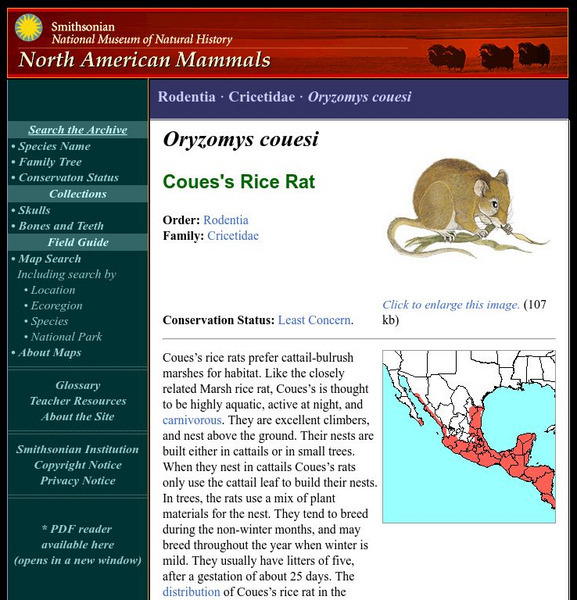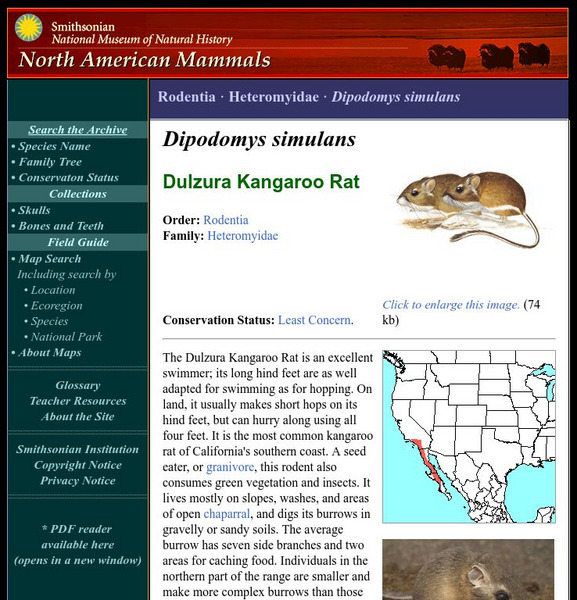Canadian Museum of Nature
Canadian Museum of Nature: Ord's Kangaroo Rat
Get to know Ord's Kangaroo Rat.. colored photos, description, life cycle, map of habitat, food. Only the basic details of this little rodent are given, making this site perfect for younger researchers.
Smithsonian Institution
National Museum of Natural History: American Mammals: Bushy Tailed Woodrat
Bushy-tailed Woodrats are highly territorial. A male will permit a female in his territory, but not another male. Learn more about the Neotoma cinerea, more commonly known as a Bushy-tailed Woodrat, in this easy-to-read species overview...
Smithsonian Institution
National Museum of Natural History: American Mammals: Arizona Woodrat
Arizona Woodrats (or Packrats) typically have litters of two young, which can be born at any time of the year. Newborns weigh about 10 g. Learn more about the Neotoma devia, more commonly known as an Arizona Woodrat, in this easy-to-read...
Smithsonian Institution
National Museum of Natural History: American Mammals: Allegheny Woodrat
The Allegheny Woodrat is the only woodrat in its Appalachian Mountain range. Instead of building large stick houses, these Woodrats build cup-shaped nests of twigs, bark bits, and grass in rocks and buildings. Learn more about the...
Smithsonian Institution
National Museum of Natural History: American Mammals: Arizona Cotton Rat
All cotton rats have a strong connection with grass, which they feed upon, and in which they construct their runways. Within their range in southeast and central Arizona and western Mexico, Arizona cotton rats inhabit only grassy areas...
Smithsonian Institution
National Museum of Natural History: American Mammals: Big Eared Kangaroo Rat
The Big-eared Kangaroo Rat has the longest ears of any kangaroo rat, and weighing in at about 85 g, is one of the largest Dipodomys species in California. It is dark cinnamon in color, with white underparts and brown ears. Learn more...
Smithsonian Institution
National Museum of Natural History: American Mammals: California Kangaroo Rat
California Kangaroo Rats require open areas away from the humidity of the coast in northern California and southern Oregon. They seem to need well-drained soil, and after a rain can be seen pushing mud out of their burrows. Learn more...
Smithsonian Institution
National Museum of Natural History: American Mammals: Agile Kangaroo Rat
Agile Kangaroo Rats are excellent swimmers. They can run on all four feet as well as hop on their large hind feet, and if they are fleeing a predator, can make sharp turns. Learn more about the Dipodomys agilis, more commonly known as an...
Smithsonian Institution
National Museum of Natural History: American Mammals: Chisel Toothed Kangaroo Rat
The Chisel-toothed Kangaroo Rat has chisel-shaped lower incisors, with which it strips the epidermis from the leaves of desert shadscale or saltbush, thereby reaching the palatable and water-rich interior of the leaf. This Kangaroo Rat...
Smithsonian Institution
National Museum of Natural History: American Mammals: White Throated Woodrat
Woodrats are also known as Packrats, because they cache various manmade objects in their dens. This habit of collecting foreign objects is useful to scientists, who can place numbered sticks throughout an area and later open a den,...
Smithsonian Institution
National Museum of Natural History: American Mammals: Stephen's Woodrat
Juniper trees are the main source of food, water, and shelter for Stephen's Woodrat. Like Red Tree Voles, which feed mostly on Douglas-fir, the Woodrats are able to feed primarily on conifer leaves, which contain chemical compounds -...
Smithsonian Institution
National Museum of Natural History: American Mammals: Southern Plains Woodrat
Southern Plains Woodrats are found in places where grasses, creosotebush, mesquite, and cactus grow. Local populations can reach high levels and then crash. Learn more about the Neotoma micropus, more commonly known as a Southern Plains...
Smithsonian Institution
National Museum of Natural History: American Mammals: Mexican Woodrat
Mexican Woodrats inhabits rocky outcrops, cliffs, and slopes, primarily in montane regions from northern Colorado to Honduras. They eat a wide variety of leaves, seeds, and berries, and sometimes store large amounts of food. Learn more...
Smithsonian Institution
National Museum of Natural History: American Mammals: Marsh Rice Rat
Marsh rice rats are among the most common mammals inhabiting tidal marshes of the Gulf and Atlantic coasts. Being good swimmers, diving to 10 m and crossing 300 m stretches of water, and able climbers, these rice rats are suitably...
Smithsonian Institution
National Museum of Natural History: American Mammals: Yellow Nosed Cotton Rat
Voles and cotton rats usually live in different geographic regions, but both groups of small rodents eat grass and make runways. Yellow-nosed Cotton Rats are especially vole-like because they are small and live in grassy patches of...
Smithsonian Institution
National Museum of Natural History: American Mammals: Tawny Bellied Cotton Rat
The tawny-bellied cotton rat is the largest of the Sigmodon species, and dominates other cotton rats where more than one species occurs. Its back fur has a speckled, "salt and pepper" look, and its underparts are buff-colored, giving it...
Smithsonian Institution
National Museum of Natural History: American Mammals: Stephen's Kangaroo Rat
Stephen's Kangaroo Rat is endangered, chiefly due to habitat loss. It lives only in isolated populations in three counties of southern California. Learn more about the Dipodomys stephensi, more commonly known as a Stephen's Kangaroo Rat,...
Smithsonian Institution
National Museum of Natural History: American Mammals: Panamint Kangaroo Rat
The Panamint Kangaroo Rat lives where vegetation includes creosote bush, cactus, yucca, juniper trees, and Joshua trees. A seed eater, this Kangaroo Rat makes particularly efficient use of its external cheek pouches, as it removes the...
Smithsonian Institution
National Museum of Natural History: American Mammals: Merriam's Kangaroo Rat
Like all members of the family Heteromyidae, Merriam's Kangaroo Rat is found only in the New World. Many kangaroo rats have rather specific habitat preferences, but Merriam's Kangaroo Rat is not one of these. Learn more about the...
Smithsonian Institution
National Museum of Natural History: American Mammals: Narrow Faced Kangaroo Rat
The Narrow-faced Kangaroo Rat, also known as the Santa Cruz Kangaroo Rat, occurs in central coastal California where annual rainfall is 75 cm and temperatures are moderate. It requires well-drained, deep soils and is often found on...
Smithsonian Institution
National Museum of Natural History: American Mammals: Ord's Kangaroo Rat
By occupying the short grass prairie of the Great Plains, and a variety of habitats where there are fine-textured, sandy soils, Ord's Kangaroo Rat has managed a truly enormous geographic distribution. The varied habitats that it occupies...
Smithsonian Institution
National Museum of Natural History: American Mammals: Texas Kangaroo Rat
Texas Kangaroo Rats live in only a few counties of north-central Texas, although the species was once also present in Oklahoma. They prefer to live where soils have a high percentage of clay. Learn more about the Dipodomys elator, more...
Smithsonian Institution
National Museum of Natural History: American Mammals: Coues's Rice Rat
Coues's rice rats prefer cattail-bulrush marshes for habitat. Like the closely related Marsh rice rat, Coues is thought to be highly aquatic, active at night, and carnivorous. Learn more about the Oryzomys couesi, more commonly known as...
Smithsonian Institution
National Museum of Natural History: American Mammals: Dulzura Kangaroo Rat
The Dulzura Kangaroo Rat is an excellent swimmer; its long hind feet are as well adapted for swimming as for hopping. On land, it usually makes short hops on its hind feet, but can hurry along using all four feet. Learn more about the...



